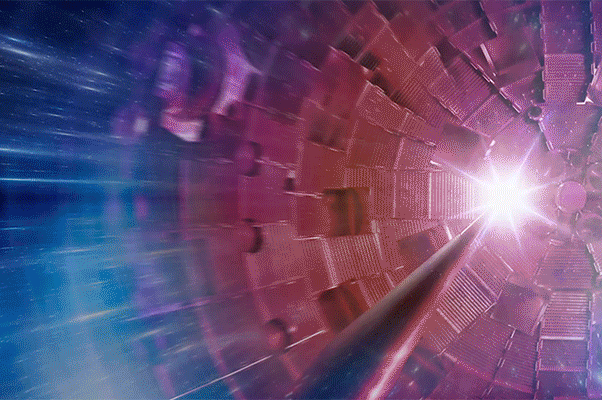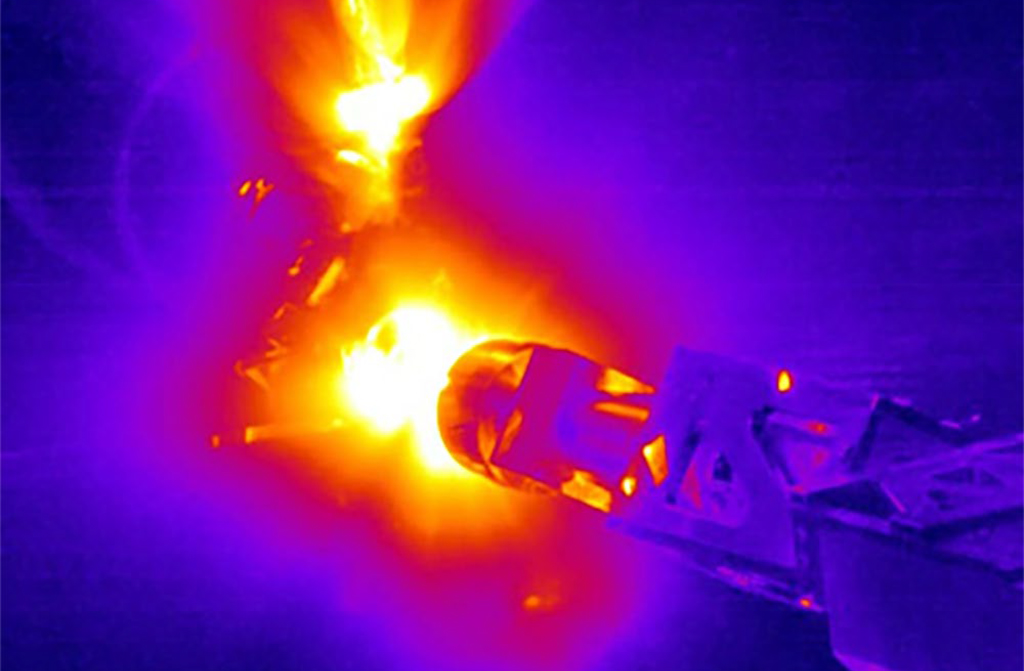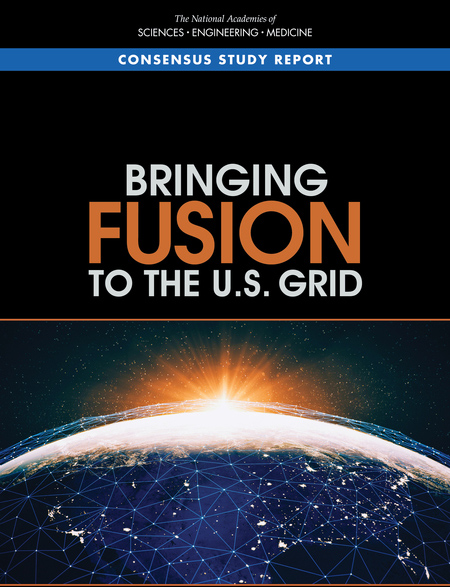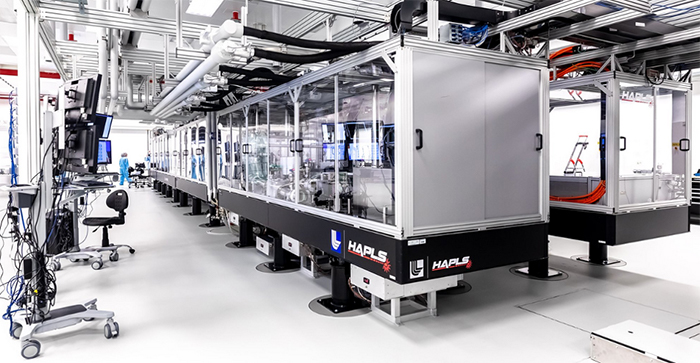Milestone Shot Enhances Future of Stockpile Stewardship and Fusion Energy Science
February 15, 2022
Last in a series of articles describing aspects of the National Ignition Facility’s record-breaking 1.3-megajoule experiment.
Part 1: “Building to a Solution: The Elements of a Fusion Breakthrough”
Part 2: “‘Hybrid’ Experiments Drive NIF Toward Ignition”
Part 3: “NIF Diagnostics Played Key Role in Fusion Milestone”
Part 4: “High-Quality Diamond Capsule Enhanced NIF’s Record-Energy Shot”
Part 5: “Laser Improvements Contributed to Record Fusion Experiment”
Part 6: “Models and Simulations Help Map NIF’s Path to Ignition”
When the National Ignition Facility (NIF) fired a laser shot on Aug. 8, 2021, that came close to achieving nuclear fusion ignition through inertial confinement fusion (ICF), the scientific world immediately took notice. Two of the fields that stand to gain from NIF’s record shot are stockpile stewardship science and the quest for inertial fusion energy (IFE).

The National Nuclear Security Administration (NNSA)’s science-based Stockpile Stewardship Program (SSP) funds Lawrence Livermore National Laboratory (LLNL)’s work to maintain the safety, security, and reliability of the nation’s nuclear deterrent—the Laboratory’s primary mission. NIF plays a significant role in SSP research. Accessing the energies of fusion ignition will enable stockpile stewardship experiments at a new level of high energy density (HED) conditions.
Meanwhile, fusion researchers around the world are working to develop the technology to generate electricity through fusion. Achieving ignition could lay the groundwork for developing an IFE-based power plant that could someday provide a safe, carbon-free, limitless, and sustainable source of electricity.
Both fusion and SSP researchers benefited from “the shot” heard around the scientific community because both controlled and uncontrolled fusion take place at the same HED conditions—pressures of hundreds of billions of Earth atmospheres and temperatures in the hundreds of millions of degrees, hotter than the core of the sun.
“Matter behaves differently at high temperatures and pressures. Understanding this behavior is fundamental to our understanding of how nuclear weapons work.”
—Mark Herrmann, program director, Weapons and Complex Integration’s Physics and Design Program
“There are many really cool pieces of data from this experiment,” said Mark Herrmann, program director for the Weapon Physics and Design Program in LLNL’s Weapons and Complex Integration Principal Directorate. “It’s really a testament to this Lab and the ability to move the needle on hard S&T things,” he said, “and the commitment to understand the very important processes that go on in our nuclear weapons, and our partnerships with many external partners—General Atomics, Los Alamos and Sandia national laboratories, the University of Rochester, and many others.”
It was “definitely a game-changer in terms of our capabilities,” Herrmann said. “It vastly expands the landscape of what we can aspire to and really increase our impact on stewardship.”
Ignition and Stockpile Stewardship
After years of experiments that produced energies in the kilojoule range, the fuel in the peppercorn-sized capsule of the Aug. 8, 2021, shot yielded 1.35 megajoules (MJ), eight times more energy than the previous record shot and about 70 percent of the 1.92 MJ fired by NIF’s 192 lasers.
Ignition through ICF is defined to take place, according to the National Academy of Science and NNSA, when a NIF implosion yields as much or more fusion energy than the amount of laser energy delivered to the target.
 Image of a NIF experiment at the moment of peak implosion. This experiment was aimed at developing a high-pressure strength measurement capability for plutonium.
Image of a NIF experiment at the moment of peak implosion. This experiment was aimed at developing a high-pressure strength measurement capability for plutonium. For the Stockpile Stewardship Program, the record shot provides access to a new regime of high-energy-density plasmas to test and verify the Laboratory’s nuclear weapons-related simulation codes. NIF performs experimental studies of fusion ignition and its subsequent thermonuclear burn, which provides the immense energy of modern nuclear weapons.
NIF’s capabilities are essential for stockpile stewardship. When the United States ended the testing of nuclear devices in the 1990s, the nuclear security enterprise moved to a new model of assuring the stockpile’s readiness. Stockpile stewardship uses high-performance computing and simulation to model the physics of weapons systems during and after detonation, combined with hydrodynamic tests on NIF and other facilities that explore the behavior of materials under extreme conditions of temperature and pressure.
In recent years, subcritical tests, which subject small samples of plutonium to these conditions—in amounts so low that the samples are incapable of going critical—have also been crucial to stockpile stewardship research. Over the years, NIF has achieved higher and higher fusion yields, providing better data to improve the computer models. But without the ability to experiment and gather data in the exact conditions where fusion ignition takes place, the fidelity of nuclear-weapon simulations is not as certain as researchers would like.
“Fundamentally, nuclear weapons operate at high energy density conditions,” Herrmann explained. “Matter behaves differently at high temperatures and pressures. Understanding this behavior is fundamental to our understanding of how nuclear weapons work.
“When we stopped testing more than 30 years ago, we lost experimental access to the HED regime,” he said. “We needed to reconstitute our access to this regime through the experiments we perform at NIF.”
Needed: Focused Experiments
Several needs of the SSP are laid out in a National Academies of Sciences, Engineering, and Medicine (NASEM) report, Plasma Science: Enabling Technology, Sustainability, Security, and Exploration, released in May 2020. Stockpile stewardship requires enhanced capabilities to recreate more weapon-like conditions in experimental facilities, the report noted.
 NIF experiments are uniquely capable of informing and validating three-dimensional weapons-simulation computer codes that support the W80-4 Life Extension Program (LEP) effort.
NIF experiments are uniquely capable of informing and validating three-dimensional weapons-simulation computer codes that support the W80-4 Life Extension Program (LEP) effort. Each year, the three national nuclear security laboratories—LLNL, Los Alamos, and Sandia—perform an annual assessment for the president certifying the readiness of the stockpile. These assessments require focused experiments such as characterizing materials used in the nuclear stockpile at HED conditions.
Those conditions are also necessary to understand the impacts on nuclear device performance of aging components in the stockpile, according to the report. As new materials and processes are applied to renew weapon systems in the stockpile through life-extension and modification programs, these materials and processes must be tested under HED conditions. Finally, evaluating the HED plasma environment requires innovative, sophisticated diagnostics capable of accurate measurements under burning plasma conditions.
NIF’s technological innovations include many such advanced diagnostics—the instruments that measure experimental results—and data from these instruments helped researchers achieve the near-ignition conditions of the Aug. 8 shot. At ICF temperatures and energy densities, it will now be possible to access the conditions needed to validate stockpile stewardship simulation codes to higher fidelity at weapons-relevant conditions through experiments at NIF (see “Fusion Supports the Stockpile”).
“All modern nuclear weapons rely on nuclear fusion and so we study fusion to better understand how the weapons operate,” Herrmann said. “But another reason the shot is important is that this fusing plasma released a lot of energy in a very short time, generating far higher peak powers than NIF’s lasers can generate. That higher power output from fusion will let us access phenomena experimentally that we don’t have access to today.”
Prospects for Inertial Fusion Energy
The record shot has also helped fuel new discussions about the possibility of harnessing fusion to generate energy for the electric grid. Federal funding of IFE has been low to nonexistent in recent years. Recent reports by the national academies and an influential DOE advisory committee have recommended stepped-up U.S. investments in fusion energy. The success of NIF’s shot has bolstered the view within the fusion R&D community that achieving ignition through inertial confinement is now very close, making the possibility of harnessing fusion to generate electricity much more real.
Recent reports by the national academies and an influential DOE advisory committee have recommended stepped-up U.S. investments in fusion energy. The success of NIF’s shot has bolstered the view within the fusion R&D community that achieving ignition through inertial confinement is now very close, making the possibility of harnessing fusion to generate electricity much more real.
“This result places NIF on the threshold of fusion ignition for the first time ever,” said Tammy Ma, the NIF&PS program element leader for High-Intensity Laser High Energy Density Science. “And it demonstrates the feasibility of laboratory-scale laser-driven inertial confinement fusion to achieve high-yield conditions.“
Building on support within the R&D community for a renewed push on IFE, Livermore is working to coordinate with the U.S. Department of Energy (DOE) national labs, their academic partners in HED physics research, and the private sector to shape a proposal for IFE research.
A workshop on IFE led by Livermore’s Alex Zylstra was held in mid-November 2021 to bring the community together, and another followed in February 2022. The White House held a Fusion Energy Summit on March 17, and DOE scheduled a basic research needs workshop to plan an IFE research portfolio later in the year.
Although the August shot helped ignite a fire in the fusion community, many steps lie ahead. The first, according to Ma, is achieving ignition. Next is demonstrating high gain: although energy gain of, for example, one percent over input energy qualifies as ignition under the NAS/NNSA definition, a working power plant would need a much higher return on energy—perhaps 100 times as much.
The research would also have to demonstrate the repeatability of this energy output, shot after shot, with shots occurring 10 times a second or more. Finally, as the research community turns to IFE power plant design, the economics of producing electricity must be demonstrated to be favorable.
 The LLNL-developed L3-HAPLS (High Rep-Rate Advanced Petawatt Laser System) at the ELI Beamlines Research Center in the Czech Republic is capable of firing at a repetition rate of 10 Hz (10 shots per second). Credit: ELI Beamlines
The LLNL-developed L3-HAPLS (High Rep-Rate Advanced Petawatt Laser System) at the ELI Beamlines Research Center in the Czech Republic is capable of firing at a repetition rate of 10 Hz (10 shots per second). Credit: ELI Beamlines “Economics is the name of the game in IFE,” Ma said. “We will need more efficient lasers, cost-effective production of the fuel pellets, streamlined heat extraction and energy conversion, and other improvements.”
While the Aug. 8 NIF shot fell just short of ignition, Ma believes that now is the time to move forward with IFE research: “There’s lots of new advancements to justify it,” she said—“high-repetition-rate lasers, artificial intelligence to help with data analysis, new physics diagnostics, advanced materials.
“Even though we haven’t achieved ignition, we’ve been making good progress toward it, and inertial fusion energy is such a big ‘grand challenge’ that you can’t wait to achieve ignition to start on the development of the other needed technologies—otherwise you’re already behind!”
Scoping the Requirements
An electricity-producing IFE power plant would require such technologies as a driver and target injection and tracking system, all operating at high repetition rates. It would also need an energy conversion system to produce electricity from heat, robust first walls around the fusion source, and blankets made of robust materials to protect the walls from the high temperatures.
“It’s important for the vitality of a field like fusion to have the private sector involved.”
—Tammy Ma, Advanced Photon Technologies Program Element leader for High-Intensity Laser High Energy Density Science
Other elements of a working fusion power system would include technologies for tritium breeding, processing and recovery, remote maintenance systems, and more.
NIF will play a significant role in any such research program. Although it is not designed to generate electricity—it is a research tool—NIF is currently the only place in the world where integrated experiments at the megajoule level are possible. The facility is where researchers can test the robustness of designs, the target-driver sensitivities that govern which shots achieve fusion burn, and the factors that cause them to fall short, such as asymmetries and target imperfections.
The fusion field has collectively received a psychological upsurge from the milestone shot, including a budding private-sector fusion start-up community funded by venture capital.
“The NIF result does not invalidate other fusion technologies—in fact, it provides a potential boost to them,” Ma explained. “This shot demonstrates that our high-energy density simulation codes were not all that far off. The same fundamental set of simulations proves that our approach is in the right ballpark” (see “Models and Simulations Help Map NIF’s Path to Ignition”).
Private-sector startups are investigating other strategies to igniting fusion, such as compact tokamaks to achieve magnetic confinement fusion. “It’s important for the vitality of a field like fusion to have the private sector involved,” Ma said. “They have a different way of looking at things. They’re focused on a smaller scale, and they can potentially accept more development risk.”
Inspiring Future Scientists
The NASEM plasma science report called out an important “soft” benefit of reaching the realm of ignition under controlled experimental conditions: It helps promote academic alliances to recruit and train new generations of scientists.
The investments supported by NNSA and DOE’s Office of Science have made the United States the world leader in HED science, giving the nation a competitive advantage.
When it was completed in 2009, NIF operated with 60 times more energy than the next biggest laser in the world, the Omega Laser Facility, also in the United States. Now, nearly a decade later, NIF operates with 10 to 20 times the energy of the next most energetic laser, which is in China.
“This world leadership,” Ma said, “along with the compelling scientific opportunities—especially the grand challenge of inertial confinement fusion ignition and the potential of a path to inertial fusion energy—has been a magnet for the best and brightest scientists and engineers to pursue research in HED science and to work as part of the SSP.”
Ma also pointed out mutually beneficial synergies between IFE and the needs of stockpile stewardship. Advanced targets that could yield high gain for IFE could produce high neutron yield for stewardship applications. Improvements in driver cost and repetition rate for IFE could similarly mean more high-energy-density experiments for SSP.
“We can now do two things that we could not before,” Herrmann noted. “We can refine our simulations of the fusion ignition process to better match what really happens during fusion. We can now also use the energy output from these fusion experiments to study and understand new phenomena—at energies that we couldn’t reach before.”
More Information
“Self-heating plasmas offer hope for energy from fusion,” Nature, January 26, 2022
“Lasers Without Limits,” Science & Technology Review, July, 2021
“Reports Recommend Stepped-Up U.S. Investment in Fusion Energy,” NIF & Photon Science News, March 8, 2021
“Fusion Supports the Stockpile,” Science & Technology Review, March, 2021
Plasma Science: Enabling Technology, Sustainability, Security, and Exploration, National Academies of Sciences, Engineering, and Medicine, May, 2020
“Superfast, Superpowerful Lasers Are About to Revolutionize Physics,” Scientific American “Observations,” March 19, 2020
“Why Ignition? NIF Experiments and Stockpile Stewardship,” NIF & Photon Science News, June, 2018
An Assessment of the Prospects for Inertial Fusion Energy, National Research Council, 2013
—Allan Chen
Follow us on Twitter: @lasers_llnl



